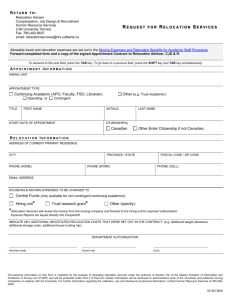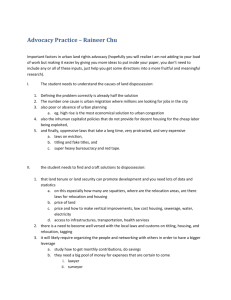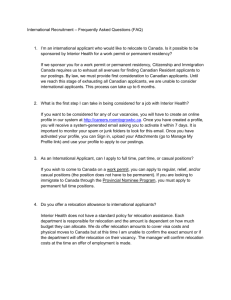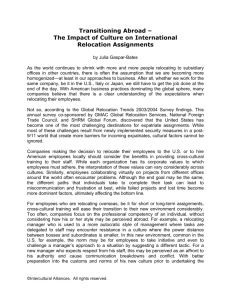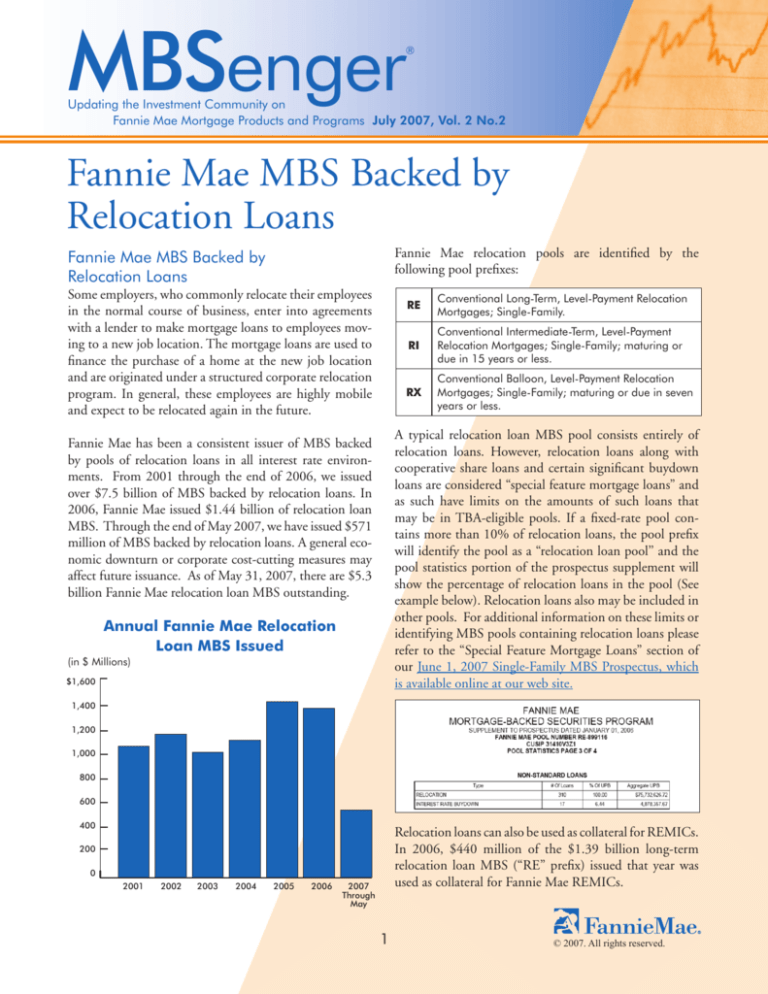
MBSenger
®
Updating the Investment Community on
Fannie Mae Mortgage Products and Programs July 2007, Vol. 2 No.2
Fannie Mae MBS Backed by
Relocation Loans
Fannie Mae relocation pools are identified by the
following pool prefixes:
Fannie Mae MBS Backed by
Relocation Loans
Some employers, who commonly relocate their employees
in the normal course of business, enter into agreements
with a lender to make mortgage loans to employees moving to a new job location. The mortgage loans are used to
finance the purchase of a home at the new job location
and are originated under a structured corporate relocation
program. In general, these employees are highly mobile
and expect to be relocated again in the future.
RE
Conventional Long-Term, Level-Payment Relocation
Mortgages; Single-Family.
RI
Conventional Intermediate-Term, Level-Payment
Relocation Mortgages; Single-Family; maturing or
due in 15 years or less.
RX
Conventional Balloon, Level-Payment Relocation
Mortgages; Single-Family; maturing or due in seven
years or less.
A typical relocation loan MBS pool consists entirely of
relocation loans. However, relocation loans along with
cooperative share loans and certain significant buydown
loans are considered “special feature mortgage loans” and
as such have limits on the amounts of such loans that
may be in TBA-eligible pools. If a fixed-rate pool contains more than 10% of relocation loans, the pool prefix
will identify the pool as a “relocation loan pool’’ and the
pool statistics portion of the prospectus supplement will
show the percentage of relocation loans in the pool (See
example below). Relocation loans also may be included in
other pools. For additional information on these limits or
identifying MBS pools containing relocation loans please
refer to the “Special Feature Mortgage Loans” section of
our June 1, 2007 Single-Family MBS Prospectus, which
is available online at our web site.
Fannie Mae has been a consistent issuer of MBS backed
by pools of relocation loans in all interest rate environments. From 2001 through the end of 2006, we issued
over $7.5 billion of MBS backed by relocation loans. In
2006, Fannie Mae issued $1.44 billion of relocation loan
MBS. Through the end of May 2007, we have issued $571
million of MBS backed by relocation loans. A general economic downturn or corporate cost-cutting measures may
affect future issuance. As of May 31, 2007, there are $5.3
billion Fannie Mae relocation loan MBS outstanding.
Annual Fannie Mae Relocation
Loan MBS Issued
(in $ Millions)
$1,600
1,400
1,200
1,000
800
600
400
Relocation loans can also be used as collateral for REMICs.
In 2006, $440 million of the $1.39 billion long-term
relocation loan MBS (“RE” prefix) issued that year was
used as collateral for Fannie Mae REMICs.
200
0
2001
2002
2003
2004
2005
2006
2007
Through
May
© 2007. All rights reserved.
Credit Characteristics
Commencing about 12 months after issuance,
prepayments tend to speed up as the relocated employee
moves to the next corporate project or position in a new
location and a relocation loan MBS will experience
increased turnover-related prepayments. If interest rates
rise, prepayments tend to remain relatively faster after the
first one or two years because of the inherent cycles of
relocation among these borrowers, frequently two or
more relocations in a five year period. In addition, a fall
in interest rates may cause the employer to encourage the
employee to refinance the loan through so-called “forced
refinancing” clauses.
Relocation loan borrowers tend to move frequently and
demonstrate a high rate of repeat relocations, yet they
have superior job stability. The loans are typically extended to mobile, well-educated and financially sophisticated
managers and professionals at larger sized companies. The
loans are predominately purchase money transactions and
generally have higher loan-to-value ratios than a conventional loan counterpart.
Relocation loans often involve financial contributions by
the employer, which can include subsidies to cover closing costs, interest rate buydowns or below market interest
rates. Relocation mortgage rates may be originated at rates
25 to 50 basis points below market interest rates for similar conventional mortgages. The lender may also provide
dedicated staff of home loan consultants, who are trained
to address the needs of transferring employees who are
buying or selling a home which can result in faster and
cheaper loan processing.
Pricing Indications
The following pricing indications were recently* observed for
Fannie Mae long-term relocation loan MBS (“RE” prefix):
Prepayment Patterns
Relocation loan MBS have historically prepaid faster
than similar conventional products in most interest rate
environments and may provide some level of extension
protection in rising interest rate environments. However, they exhibit a different seasoning pattern in the first
12 months or so after origination as compared to conventional 30-year (“CL” prefix) or 15-year (“CI” prefix)
fixed-rate MBS. They tend to prepay slower than their
conventional counterparts during those initial 12 months
with differentials of as much as 10 to 15 CPR having
been observed. An employer is not likely to facilitate an
employee’s relocation unless both employer and employee
anticipate tenure at the new location of a year or longer,
so they may be significantly less responsive to refinancing
opportunities early in the life of the loan. In addition,
employer subsidies generally lower the borrower’s monthly payment and reduce that borrower’s sensitivity to raterelated refinancing during the period of the subsidy early
in the life of the loan.
Coupon
Price versus Fannie Mae 30-year
“CL” TBA MBS (32nds)
4.5%
+34
5.0%
+22
5.5%
+9
6.0%
+0.5
*Indications as of June 26, 2007. The 10-year Treasury yield on that date was 5.10%
Federal Reserve Statistical Release H.15 Release Date: June 27, 2007
Fannie Mae MBS backed by relocation loans have features
that indicate relatively fast prepayment speeds in nearly all
interest rate environments, primarily from turnover prepayments. The borrowers tend to be well-educated and
financially aware. We have been a consistent issuer of the
product and it has characteristics that may make it attractive to investors seeking a cushion against extension risk.
MBSenger is published by Fannie Mae’s
Fixed-Income Marketing Group
Fannie Mae Fixed-Income Investor Helpline
(800) 237-8627
Wayne B. McLurkin
Director, Fixed-Income Marketing
(202) 752-7796
wayne_b_mclurkin@fanniemae.com

